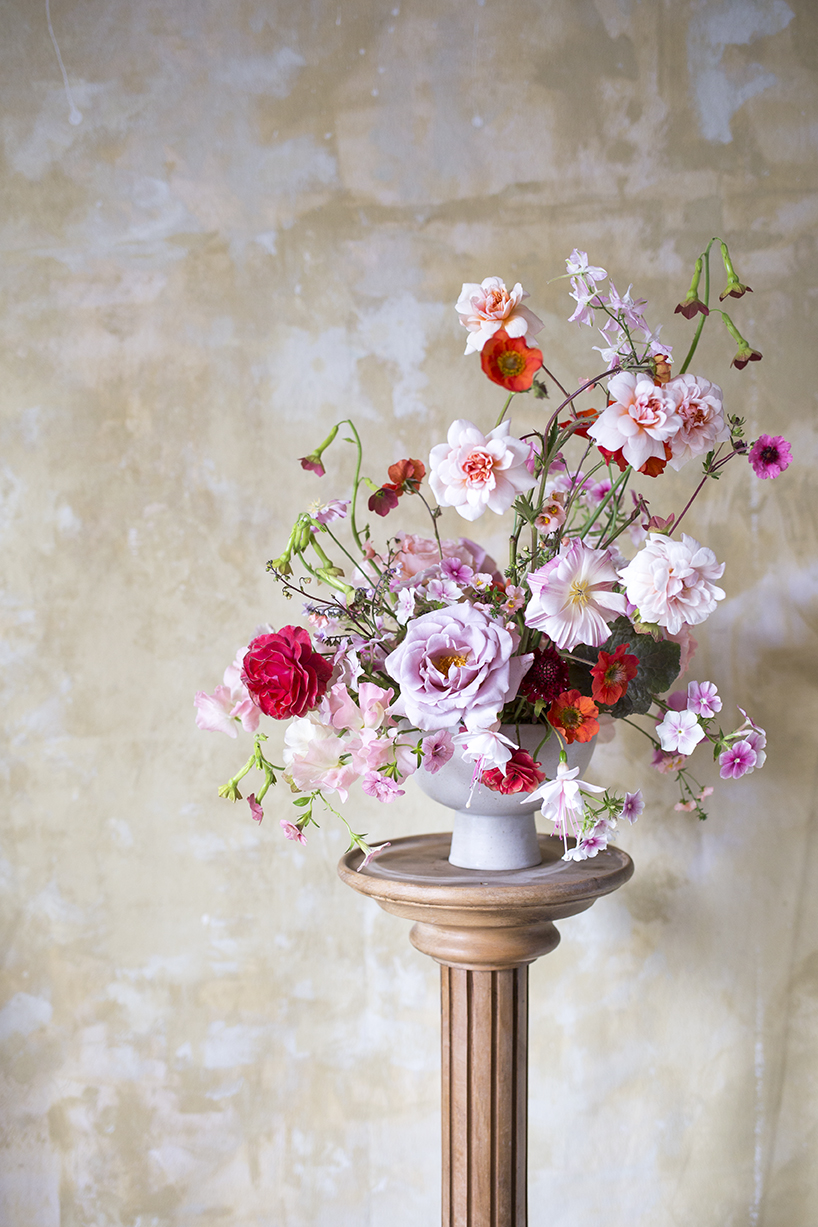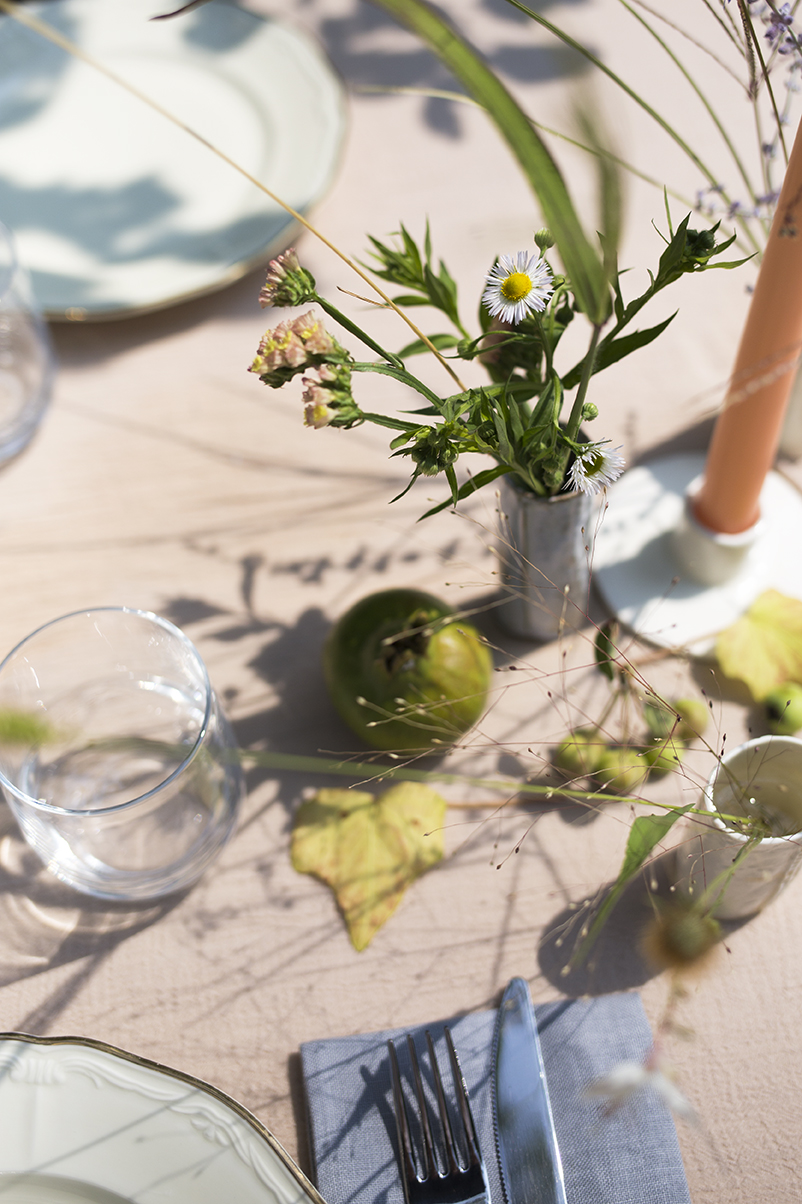37 degrees in London
IN THE STUDIO
It is currently 37 degrees in London, stifling and still, pollen drifting slowly in mid air. Landing back at Heathrow last night, it was barely cooler than Italy, the same humid blanket of heat and haze spreading across Western Europe. Too hot to work - almost too hot to write - it has taken most of my energy today just to unpack, water the garden and occasionally pad barefoot to the kitchen for more iced elderflower water.
July has been another wonderfully full and floral month in the studio with private and group classes and as always we have loved welcoming guests to our leafy haven in the city, sharing ideas, great flowers and cafetieres of strong coffee in between lulls of companionable non-conversation and concentration. Flower arranging never ceases to be meditative, even when there is a lot of it to be done in a little time (as is often the case for us in the run-up to weddings or events); it quietens and calms and focuses in a way that I think is quite addictive to those who really embrace and enjoy it.
Recently I’ve tried to build in time for more creative experimentation whenever I get the chance; working with flowers and plants there is always so much more to learn and to try, different combinations of materials, different techniques. It is easy to fall into the trap of replicating, particularly when it is your job, and sometimes it is nice to make something that isn’t for sale, isn’t ‘appropriate’ or proportionate or even finished. In our classes we always say that the goal is to experiment, to try something new, not to worry about getting it exactly ‘right’, to take it apart if you’re not happy with it, to start over, mostly just to enjoy it; flowers are, after-all, the greatest luxury. When you are arranging for a client the over-riding priority is the End Result. When you’re arranging for yourself it is the process that takes precedence, that peculiarly ecstatic state of mind when you are coasting, not thinking about anything, finally. And then, after some time, and all of a sudden, you are flooded with new ideas.
To quote from the book I recommended in the last post (still so much at the the forefront of my mind that I am re-reading earlier chunks of it) To The River by Olivia Laing -
‘I was getting anyway into one of those trances that come from walking far, when the feet and the blood seem to collide and harmonise. Funnily enough, Kenneth Grahame and Virginia Woolf both wrote in praise of these uncanny states, which they thought closely allied to the inspiration writing requires. ‘Nature’s particular gift to the walker,’ Grahame explained in a late essay, ‘through the semi-mechanical act of walking - a gift no other form of exercise seems to transmit in the same degree - is to set the mind jogging, to make it garrulous, exalted, a little mad maybe - certainly creative and supra-sensitive, until at last it really seems to be outside of you and as if it were talking to you, while you are talking back to it.’ As for Woolf, she wrote dreamily of chattering her books on the crest of the Downs, the words pouring from her as she strode, half-delirious, in the noon-day sun. She compared it to swimming, or ‘flying through the air, the current of sensations & ideas; & the slow, but fresh change of down, of road, of colour: all this is churned up into a fine thin sheet of perfect calm happiness. It is true I often painted the brightest pictures on this sheet: & often talked out loud’.
I feel like this when I am arranging flowers.
Next week the studio will be closed. We are all taking a break after the summer rush to go offline, stretch our horizons and re-energise with some coastal walks, fresh fish and early nights ahead of a busy August. More from the studio then!
IN THE GARDEN
It is that point in the season when there begin to be momentary glimpses of the next; the sorrel in the hedgerows turning rusty pink and burnt amber, the summer-weary earth is parched, little cracks appearing in the dust like miniature fault-lines. At the farm we’ve been making steady progress; it’s been a month of maintenance and weed control - so difficult to keep on top of in the height of the summer but made far easier with extra help. With the first flush over there is a brief lull before the next crops really get going - perhaps a little later this year because of the long, cold spring - the flowers of high to late summer - dahlias, zinnias, rudbeckia, scabiosa, daucus carota and everlastings. And vegetables too - lettuce and cabbages, french beans, radish and tomatoes. We harvest buckets of poppy seed-heads, so useful for the autumn, and already turning from that misty blue-green to tobacco brown and gold.
IN ITALY | GIARDINO ESTIVO WORKSHOP
Late last week Jess and I flew to Milan and drove north, spending the weekend on Lake Como. It was beautiful: terracotta, primrose and ochre villas with tiered gardens and shutters painted dusky blue, turquoise and emerald, hills brushed with mist, frangipani blossoming and trailing in the lake water that turned gold at dusk. Striped awnings, stone terraces of vines, water slapping the underbellies of boats and above the hills - pine, ferns, wild strawberries and hydrangea - the peaks not jagged but soft and undulating, blanketed with forests.
Not missing the chance to visit an Italian garden while we had a few hours spare we visited Villa Balbianello at Lenno. Built in the late 1780s by a wealthy cardinal, and most recently owned by handsome explorer Count Guido Monzino before passing to the Fondo per l'Ambiente Italiano (the National Trust of Italy) upon his death in 1988, the villa and its gardens are deceptively small and rather formal. But worth travelling a way to see was the snake-shaped Ficus which entwines the loggia, and the evergreen oak pruned into the shape of an umbrella, with a view across the Lake to Bellagio. We’ll share photographs in a later post, because there are many. I’d like to go back there, probably in autumn when the camphor laurels turn red; it must be a breathtaking sight.
On Sunday we moved east into the mountains to a little village near Erba, halfway between the two ‘legs’ of Lake Como and Lecco to host a two-day workshop at Olga’s Flower Farm. On the site of a nursery run by her mother Cecilia, Olga grows beautiful annuals - rudbeckia, cosmos, zinnia, dahlias, phlox, celosia and many more which she sells to florists in Como and Milan. We were spoilt for choice, and for foliage too - most exquisite varieties of ninebark, abelia, porcelain vine and viburnum as well as apples and pomegranates. It was a treat to be thrown into what I think of as the next season almost - late summer/pre autumn, the ‘serotinal’ period according to the ecologists calendar - a couple of weeks before we begin harvesting our own. The colour palette for the workshop was dominated by these dusty reds, corals, gold, rust and toffee.
It was extremely hot, as can be expected of Italy in July, and I think heat renders a lovely, if slightly sleepy atmosphere because those two days seemed to slip by in a slow, hazy, drifting sort of way. Everything just took the time it took - cutting, arranging, tweaking, drinking espresso, moving around from shadow to shadow, from the shade of one tree to another. And all day long, the unceasing soundtrack of cicadas.
We had the most wonderful group of students - a gaggle of kind, talented, imaginative and intelligent women, many from Italy but also from Barcelona, Vienna, New York, London and Scotland. It is the greatest privilege, not only to teach and to share our passion for plants and flowers with other like-minded enthusiasts, but to travel and see other gardens, other farms, in landscapes and climates different to our own. There is as much of a thrill recognising a shared love of the same flower as there is to discovering new ones.
We stayed in an old stone farmhouse at the foot of a small, bone-shaped lake and at the overlap of two mountains rising steeply towards the cloudless sky. At night a gossamer veil of heat slithered across the forest, causing the visual illusion that distinctly individual pine trees were now merging into one another, a soft black ashy slope so close you could almost reach out from across the valley and brush it with your fingertips. The owners, an attractive and glamorous proprietress named Roberta and her husband (whose name we never caught but we instead privately named ‘Mr Fawlty’) spent the hottest part of the afternoons in their cavernous cool room off the terrace watching the flat-screen television, oddly surrounded by the family silver which was laid out on every available surface as though it had been got down for a spring clean, many springs ago, and inexplicably abandoned. After the extreme heat of the day we would tiptoe past and slip into the shockingly cold (for a minute at least) pool, which was a green as old glass, and look out at the Lombardy hills, the rows of lavender fizzing with bees, the tier of terraces bordered by rough stone walls stepping down towards the shore of the lake where a wooden cabin was stacked neatly with logs. Occasionally the resident Great Dane - a great black shire-horse of a dog, would sidle over and lean her weight against you, bizarrely accompanied by a tiny black rabbit that had an unnerving habit of popping up next to you just when you least expected it after dusk. It was a strange and beautiful place and in many ways, despite it being really only a half-day of travel away, we couldn’t have felt further from home.
Of course being Italy we had delicious food, and it would be remiss of me not to share a few tasters… a risotto with melon. Ravioli with ricotta and orange zest in Como, a divine saffron risotto in Canzo, and on the farm coffee-soaked pastries and tiny espressos to make the heart flutter, orecchiette with shrimp, iced berries and elderflower shortbread.
We would like to thank… First and foremost, our students, for being such a joy and for making it all possible. Olga, for inviting us, sharing your beautiful flowers, allowing us to snip from your shrubs and exquisite pomegranate tree! Giulia for helping us with all the hard graft, you were a wonderwoman, and also for the beautiful blackberries, flowers and grasses from your farm. Cristina and Chiara for the food, coffee and general assistance. Fati Amor for the linen and silk ribbons; Agnes Duerrschnabel Atelier for the bowls and vases and Madlen Ceramics for the candle-holders.



































































